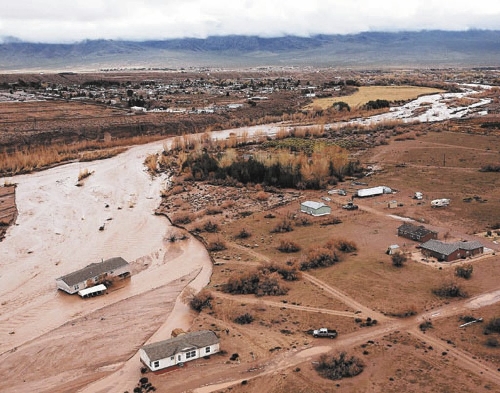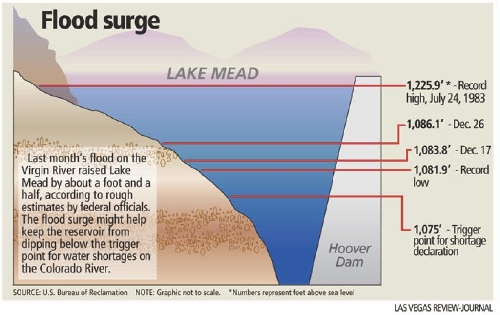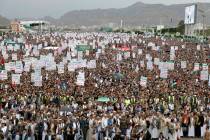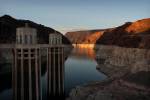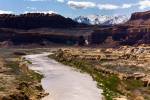Flood a boon for Lake Mead
A flood that destroyed homes near Mesquite last month also delivered a welcome boost to Lake Mead.
High flows on the Virgin River and its tributaries raised the level of the reservoir by about a foot and a half, according to rough projections from U.S. Bureau of Reclamation officials.
That might not sound like a lot, but a foot and a half of water spread across the surface of the nation's largest man-made lake totals almost 150,000 acre-feet, enough to supply about 300,000 average homes for one year and half as much water as Nevada is allowed to take from the reservoir each year.
Every foot of elevation counts right now at Lake Mead because it helps keep the surface of the drought-stricken reservoir above a federal shortage line that would force Nevada and Arizona to curtail their Colorado River use.
The trigger point for that shortage declaration is 1,075 feet above sea level. When the rain began to fall in Southern Nevada on Dec. 17, the lake sat at elevation 1,083.8. By Dec. 26, it had risen to 1,086.
Analysts think most of that water came in a rush down the Virgin River, which empties into the northern tip of Lake Mead, about 70 miles northeast of Las Vegas.
"Every little bit helps," said Rose Davis, spokeswoman for the Bureau of Reclamation in Boulder City.
Lake Mead gets nearly all of its water from snow that falls in the Rockies and melts into the Colorado River and its tributaries. Precipitation here -- even heavy rain and flooding -- generally has no measurable effect on the reservoir.
Major floods on the Virgin and Muddy rivers are the exception.
When the two rivers northeast of Las Vegas overran their banks in January 2005, the surface of Lake Mead rose about 2 feet.
Last month's storm system also helped the lake by dumping snow at the headwaters of the Colorado and soaking farms in Southern California, reducing orders for irrigation water from the river system.
"It was a win all the way around," said J.C. Davis, spokesman for the Southern Nevada Water Authority, wholesale water supplier for the Las Vegas Valley.
The water level in Lake Mead has dropped about 130 feet since record drought took hold on the Colorado 11 years ago.
Now water users are scrambling to find ways to keep Lake Mead from slipping below the 1,075 mark.
The latest suggestion comes from Arizona, where officials are discussing the possibility of leaving some of their Colorado River water in Lake Mead to forestall a shortage declaration that would hit that state the hardest.
Bob Barrett is spokesman for the Central Arizona Project, the 336-mile network of aqueducts, tunnels and pipelines that delivers Colorado River water to Phoenix, Tucson and farming districts along the way. He said that if projections later this year show Lake Mead dropping to within a foot of the shortage trigger, the Central Arizona Project will consider reducing its diversions enough to keep the reservoir above the line.
"Why not leave 50,000 to 80,000 acre-feet in Lake Mead in order to avoid a hit of 320,000 acre-feet?" Barrett said. "It's pretty simple stuff if you stop and look at it."
He said they hope their counterparts in Nevada and California will consider similar moves to help delay a shortage declaration at least for another year or two -- long enough, perhaps, to outlast the drought.
"It's like sitting at a blackjack table and drawing a push. You didn't lose, and every year Mother Nature deals a new hand," he said.
Arizona is entitled to 2.8 million acre-feet of Colorado River water each year. Nevada's annual share of the river is 300,000 acre-feet, nearly all of which goes to the Las Vegas Valley.
A shortage declaration would mean 320,000 acre-feet less water for Arizona and 13,000 acre-feet less for Nevada. Water officials in both states insist the cuts would have no effect on municipal water supplies.
Asked whether the Southern Nevada Water Authority supports Arizona's plan to leave some water on this side of Hoover Dam, J.C. Davis chuckled and said, "We're very supportive of any action that would result in Lake Mead staying above 1,075."
Elevation 1,075 is also the trigger point for a pivotal vote by the water authority board on whether to build a pipeline to tap groundwater across eastern Nevada.
Should the lake shrink another 25 feet to elevation 1,050, the authority will be forced to shut down one of the two intake pipes that supply the valley with 90 percent of its drinking water.
A third intake is under construction to draw water from deeper in Lake Mead, but the $700 million project has been delayed by flooding at the underground work site.
Lake Mead is expected to receive a temporary boost from a new international agreement that will allow Mexico to store up to 260,000 acre-feet of water in the reservoir while it repairs damage from a 7.2-magnitude quake that struck Mexicali on April 4.
That extra water could raise the surface of the lake by 3 feet or more.
The Bureau of Reclamation's latest projections, released before the flood on the Virgin River, called for Lake Mead to rise gradually through the end of March, then start back down again. The reservoir was predicted to reach a new record low in May and continue to shrink into July, when it was to bottom out just below elevation 1,078.
New projections are in the works that will reflect the effect of the Virgin River flooding and the recent snowfall in the Rockies.
The latest snowpack estimates show well-above-average accumulations in several areas that feed the Colorado River. Just don't expect forecasters and water managers to start popping champaign anytime soon.
Several times over the past decade, the snow season has gotten off to a rousing start, only to fade in late winter and early spring, typically the best months for heavy, wet snowfall.
"We're glad to be ahead rather than behind at this point," J.C. Davis said.
"It's the bottom of the second inning, so it's a little early to celebrate our victory over the drought."
Added the Bureau of Reclamation's Rose Davis, "We'll keep our toes crossed."
Contact reporter Henry Brean at hbrean@reviewjournal.com or 702-383-0350.



